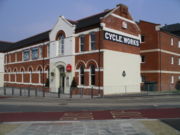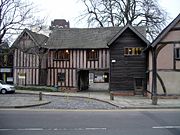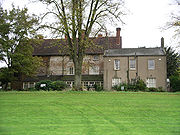
Cheylesmore
Encyclopedia
Cheylesmore is a suburb in the southern half of the city of Coventry
, West Midlands
, England
. It is one of Coventry's largest suburbs, sharing borders with Whitley
and Stivichall (also spelled Styvechale) in the South, extending into Coventry city centre and bordering with Earlsdon
in the North. Cheylesmore has two shopping parades situated in Daventry Road and Quinton Park. These shops overlook a small park and pool known as Quinton Pool.
 The Quinton Road and Mile Lane areas of Cheylesmore have been occupied by several companies that contributed to Coventry's motoring heritage, including Rolls Royce
The Quinton Road and Mile Lane areas of Cheylesmore have been occupied by several companies that contributed to Coventry's motoring heritage, including Rolls Royce
, Armstrong Siddeley
, Coventry Climax
, and the Swift Motor Company
. The suburb's proximity to large manufacturing firms resulted in a rapid expansion of the area during the 1930s with planners finding it difficult to get houses constructed in time to meet the demand for them. The advantage of the short distance between the factories and houses was that workers were able to walk to the factories, saving them the bus fare. They were also able to go home for a meal at midday before returning to work.
The former Quinton Works, originally built in 1890 as a cycle factory, situated at the junction of Mile Lane and Quinton Road was acquired by the Swift Motor Company in 1905. During World War I
the factory contributed to the war-effort, producing munitions, military bicycles, Hispano-Suiza
and Renault aircraft engines.
The frontage of the Quinton Works has been restored and integrated with a newly built Ibis Hotel, whilst most of the rest of the former site has been knocked down. New developments in this part of Cheylesmore include Cheylesmore House which is the national headquarters of the Skills Funding Agency
, a technology park for Coventry University
, and residential housing.
A new set of houses was built in 2007, on the new road Crediton Close. It looks onto Howes primary school. It is all part of new housing for Coventry
 Cheylesmore Manor Gatehouse is a grade II* listed building and the home of Coventry's Register office
Cheylesmore Manor Gatehouse is a grade II* listed building and the home of Coventry's Register office
since 1965. Parts of the building date back to 1250. Edward, the Black Prince
, and Henry VI
were among the royals who lived at the Manor House. Remnants of the house survived the Second World War
, but were demolished in 1955 as part of the post war the development of the town. Edward used Cheylesmore Manor as his hunting lodge and reputedly visited the area frequently. His grandmother Queen Isabella
, the "she-wolf" of France and the Queen of Edward II
, gained the manorial rights when the Crown had acquired them from previous owners. Edward was known as the Black Prince due to the black armour that he wore. His helmet was surmounted by a "cat-a-mountain".
The seal of the city bears the Motto "Camera Principis" or the Prince's chamber which, it is said, it owes to the close tie with the Black Prince. Also the "cat-a-mountain" of the Black Prince surmounts the Coat of arms as a crest.
In the 16th century, Edward VI granted the manor and park to John Dudley, Earl of Warwick, who as Duke of Northumberland leased it to Coventry Corporation on the condition that 80 cows and 20 geldings belonging to the poor were pastured there.
In 1819 the royal connection to Coventry Park, Cheylemore park finally ended when the Prince of Wales sold the estate to the Marquis of Hertford. In 1871 it went to H.W. Eaton, Lord Cheylesmore.
The development of Cheylesmore began in the early 20th century with the building of factories and housing in the Parkside area, close to the city, and continued outwards towards Quinton Park from the late 1920s. Quinton Pool and its surrounding green open space is now the area's only reminder of the former royal hunting park.
Manor Park Primary School, located in Cheylesmore, takes its name from the Manor house and park. The school was built as a showcase, the first built in Coventry since the end of the war. The crest of the school features a falcon hunting bird, a reference to the Cheylesmore hunting park.
 The Charter house was founded in 1381-2 as part of a Carthusian monastery by King Richard II. There were 11 cells for the monks arranged round a Great Cloister, (as usual for this Order). There was also room for the lay brothers, servants and 12 schoolboys.
The Charter house was founded in 1381-2 as part of a Carthusian monastery by King Richard II. There were 11 cells for the monks arranged round a Great Cloister, (as usual for this Order). There was also room for the lay brothers, servants and 12 schoolboys.
After the dissolution of the monastery in 1539, the majority of the buildings were demolished, leaving only the stone and timber-framed building still standing and two low wings on the west side which were demolished in 1848. It became a private house until 1940 after which it has been used as an old people's home and an Arts Center.
The main surviving building is a 15th century sandstone range which probably contained the Prior's guest-house. Some original stone corbels and wooden carved tie beams remain, as does a moulded stone fireplace and a magnificent medieval wall painting depicting the crucifixion. The timber-framed addition is of 16th century date.
Internally the building was substantially altered in the 16th century when it became a private house. An extra floor was inserted in the northern part and the medieval painting covered by paneling, which is itself finely painted. Sash windows and Georgian doors were inserted in the 18th century and the existing brick house on the south-west corner in the 19th century. The building is now listed of Grade I Architectural and Historic Interest by the Department of the Environment.
Coventry
Coventry is a city and metropolitan borough in the county of West Midlands in England. Coventry is the 9th largest city in England and the 11th largest in the United Kingdom. It is also the second largest city in the English Midlands, after Birmingham, with a population of 300,848, although...
, West Midlands
West Midlands (county)
The West Midlands is a metropolitan county in western central England with a 2009 estimated population of 2,638,700. It came into existence as a metropolitan county in 1974 after the passage of the Local Government Act 1972, formed from parts of Staffordshire, Worcestershire and Warwickshire. The...
, England
England
England is a country that is part of the United Kingdom. It shares land borders with Scotland to the north and Wales to the west; the Irish Sea is to the north west, the Celtic Sea to the south west, with the North Sea to the east and the English Channel to the south separating it from continental...
. It is one of Coventry's largest suburbs, sharing borders with Whitley
Whitley, Coventry
Whitley is a suburb of southern Coventry in the West Midlands of England.-Industry and commerce:Whitley is the home of the Whitley plant, which is the Engineering Centre and Headquarters of Jaguar Cars Limited...
and Stivichall (also spelled Styvechale) in the South, extending into Coventry city centre and bordering with Earlsdon
Earlsdon, Coventry
Earlsdon is a suburb and electoral ward of Coventry. It lies approximately one mile to the southwest of Coventry City Centre. It is the birth place of aviation pioneer Frank Whittle There are shops and several restaurants on Earlsdon Street, the main street through Earlsdon. There is also...
in the North. Cheylesmore has two shopping parades situated in Daventry Road and Quinton Park. These shops overlook a small park and pool known as Quinton Pool.
Industrial heritage and new developments

Rolls-Royce Motors
Rolls-Royce Motors was created from the de-merger of the Rolls-Royce car business from Rolls-Royce Limited in 1973. The original Rolls-Royce Limited had been nationalised in 1971 due to the financial collapse of the company, caused in part by the development of the RB211 jet engine...
, Armstrong Siddeley
Armstrong Siddeley
Armstrong Siddeley was a British engineering group that operated during the first half of the 20th century. It was formed in 1919 and is best known for the production of luxury motor cars and aircraft engines.-Siddeley Autocars:...
, Coventry Climax
Coventry Climax
Coventry Climax was a British forklift truck, fire pump, and speciality engine manufacturer.-History:The company was started in 1903 as Lee Stroyer, but two years later, following the departure of Stroyer, it was relocated to Paynes Lane, Coventry, and renamed to Coventry-Simplex by H...
, and the Swift Motor Company
Swift Motor Company
The Swift Motor Company made Swift Cars in Coventry, England from 1900 until 1931.Founded by James Starley as a sewing machine maker in 1859, the Coventry Sewing Machine Company as it was then called, started making bicycles in 1869 and changed its name to Coventry Machinists. In 1896 they became...
. The suburb's proximity to large manufacturing firms resulted in a rapid expansion of the area during the 1930s with planners finding it difficult to get houses constructed in time to meet the demand for them. The advantage of the short distance between the factories and houses was that workers were able to walk to the factories, saving them the bus fare. They were also able to go home for a meal at midday before returning to work.
The former Quinton Works, originally built in 1890 as a cycle factory, situated at the junction of Mile Lane and Quinton Road was acquired by the Swift Motor Company in 1905. During World War I
World War I
World War I , which was predominantly called the World War or the Great War from its occurrence until 1939, and the First World War or World War I thereafter, was a major war centred in Europe that began on 28 July 1914 and lasted until 11 November 1918...
the factory contributed to the war-effort, producing munitions, military bicycles, Hispano-Suiza
Hispano-Suiza
Hispano-Suiza was a Spanish automotive and engineering firm, best known for its luxury cars and aviation engines in the pre-World War II period of the twentieth century. In 1923, its French subsidiary became a semi-autonomous partnership with the parent company and is now part of the French SAFRAN...
and Renault aircraft engines.
The frontage of the Quinton Works has been restored and integrated with a newly built Ibis Hotel, whilst most of the rest of the former site has been knocked down. New developments in this part of Cheylesmore include Cheylesmore House which is the national headquarters of the Skills Funding Agency
Skills Funding Agency
The Skills Funding Agency is one of two successor organisations that emerged from the closure of the Learning and Skills Council...
, a technology park for Coventry University
Coventry University
Coventry University is a post-1992 university in Coventry, West Midlands, England. Under the terms of the Further and Higher Education Act of 1992, the institution's name was changed from Coventry Polytechnic to Coventry University...
, and residential housing.
A new set of houses was built in 2007, on the new road Crediton Close. It looks onto Howes primary school. It is all part of new housing for Coventry
Coventry
Coventry is a city and metropolitan borough in the county of West Midlands in England. Coventry is the 9th largest city in England and the 11th largest in the United Kingdom. It is also the second largest city in the English Midlands, after Birmingham, with a population of 300,848, although...
Cheylesmore Manor House

Register office
A register office is a British term for a civil registry, a government office and depository where births, deaths and marriages are officially recorded and where you can get officially married, without a religious ceremony...
since 1965. Parts of the building date back to 1250. Edward, the Black Prince
Edward, the Black Prince
Edward of Woodstock, Prince of Wales, Duke of Cornwall, Prince of Aquitaine, KG was the eldest son of King Edward III of England and his wife Philippa of Hainault as well as father to King Richard II of England....
, and Henry VI
Henry VI of England
Henry VI was King of England from 1422 to 1461 and again from 1470 to 1471, and disputed King of France from 1422 to 1453. Until 1437, his realm was governed by regents. Contemporaneous accounts described him as peaceful and pious, not suited for the violent dynastic civil wars, known as the Wars...
were among the royals who lived at the Manor House. Remnants of the house survived the Second World War
World War II
World War II, or the Second World War , was a global conflict lasting from 1939 to 1945, involving most of the world's nations—including all of the great powers—eventually forming two opposing military alliances: the Allies and the Axis...
, but were demolished in 1955 as part of the post war the development of the town. Edward used Cheylesmore Manor as his hunting lodge and reputedly visited the area frequently. His grandmother Queen Isabella
Isabella of France
Isabella of France , sometimes described as the She-wolf of France, was Queen consort of England as the wife of Edward II of England. She was the youngest surviving child and only surviving daughter of Philip IV of France and Joan I of Navarre...
, the "she-wolf" of France and the Queen of Edward II
Edward II of England
Edward II , called Edward of Caernarfon, was King of England from 1307 until he was deposed by his wife Isabella in January 1327. He was the sixth Plantagenet king, in a line that began with the reign of Henry II...
, gained the manorial rights when the Crown had acquired them from previous owners. Edward was known as the Black Prince due to the black armour that he wore. His helmet was surmounted by a "cat-a-mountain".
The seal of the city bears the Motto "Camera Principis" or the Prince's chamber which, it is said, it owes to the close tie with the Black Prince. Also the "cat-a-mountain" of the Black Prince surmounts the Coat of arms as a crest.
The Hunting park
Cheylesmore land extended well to the south beyond the Manor house, and provided a hunting park to its owner.In the 16th century, Edward VI granted the manor and park to John Dudley, Earl of Warwick, who as Duke of Northumberland leased it to Coventry Corporation on the condition that 80 cows and 20 geldings belonging to the poor were pastured there.
In 1819 the royal connection to Coventry Park, Cheylemore park finally ended when the Prince of Wales sold the estate to the Marquis of Hertford. In 1871 it went to H.W. Eaton, Lord Cheylesmore.
The development of Cheylesmore began in the early 20th century with the building of factories and housing in the Parkside area, close to the city, and continued outwards towards Quinton Park from the late 1920s. Quinton Pool and its surrounding green open space is now the area's only reminder of the former royal hunting park.
Manor Park Primary School, located in Cheylesmore, takes its name from the Manor house and park. The school was built as a showcase, the first built in Coventry since the end of the war. The crest of the school features a falcon hunting bird, a reference to the Cheylesmore hunting park.
The Charter House

After the dissolution of the monastery in 1539, the majority of the buildings were demolished, leaving only the stone and timber-framed building still standing and two low wings on the west side which were demolished in 1848. It became a private house until 1940 after which it has been used as an old people's home and an Arts Center.
The main surviving building is a 15th century sandstone range which probably contained the Prior's guest-house. Some original stone corbels and wooden carved tie beams remain, as does a moulded stone fireplace and a magnificent medieval wall painting depicting the crucifixion. The timber-framed addition is of 16th century date.
Internally the building was substantially altered in the 16th century when it became a private house. An extra floor was inserted in the northern part and the medieval painting covered by paneling, which is itself finely painted. Sash windows and Georgian doors were inserted in the 18th century and the existing brick house on the south-west corner in the 19th century. The building is now listed of Grade I Architectural and Historic Interest by the Department of the Environment.

